Ramesh Singh Summary: Economic Reforms | Indian Economy for UPSC CSE PDF Download
| Table of contents |

|
| Economic Reforms |

|
| Economic Reforms in India |

|
| Reform Measures |

|
| Liberalisation |

|
| Privatisation |

|
| Globalisation |

|
| Generations of Economic Reforms |

|
| The Reforms Approach (Current Scenario) |

|
For 25 years now, since the start of the economic reforms in 1991, there hasn't been a single day without news or discussions about them in the newspapers. Many experts, both from India and abroad, have written acclaimed books on India's economic reforms. However, even today, many students, especially those not studying economics, struggle to understand the advantages and disadvantages of these reforms.
Economic Reforms
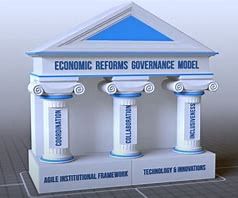
Economic reforms typically involve governments reducing their role and allowing more private sector involvement in the economy. Understanding economic reform is akin to exploring various alternative development strategies that nations adopt over time. Economists attribute differences in economic performance to these strategies, which have evolved through trial and error under different ideological influences. Examining these approaches helps clarify the concept of economic reform, particularly in the Indian context.
Planning Model
- Till the rise of the Soviet Union, the prevalent development strategy in the Euro- American countries was the capitalist system of economy, which promoted the principles of laissez-faire and dominant role for private capital in the economy.
- Once the Soviet Union went for the planning model most of the developing countries after their independence were influenced by socialism and the governments there took a central role in planned development.
- As these economies were dominated by foreign colonisers, they worried that opening the economy to foreign investment would lead to a new form of domination, the domination by large multinationals.
Washington Consensus
- By the early 1980s, a new development strategy emerged. Though it was not new, it was like the old idea getting vindicated after failure of a comparatively newer idea.
- After the world recognised the limits of a state-dominated economy, arguments in favour of the market, i.e., the private sector, was promoted emphatically.
- Many countries shifted their economic policy just to the other extreme arguing for a minimal role of the government in the economy. Governments of the socialist or the planned economies were urged/suggested to privatise and liberalise, to sell off state-owned companies and eliminate government interventions in the economy.
- These governments were also suggested to take measures which could boost the aggregate demand in the economy (i.e., macroeconomic stability measures).
- The broad outlines of such a development strategy were regarded as being inspired by the Washington Consensus.
Mixed Economy
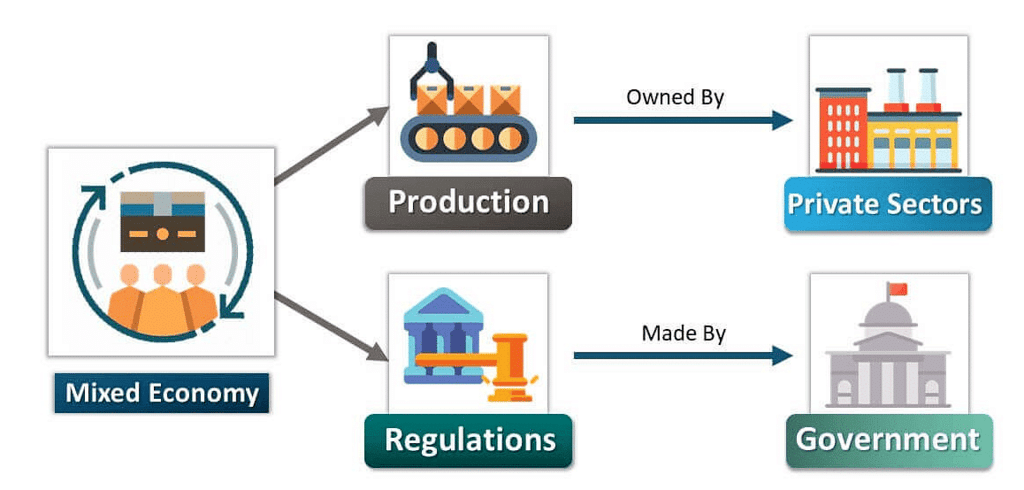
- By the mid-1990s, it had become increasingly clear that neither of the extremes—the Washington Consensus or the state-led planned economy—were the ultimate strategies of development.
- The success achieved by the East Asian economies even if we take into account their setback due to the financial crisis of 1997-98, stands out in marked contrast to the experiences of other economies of the time who were following the Washington Consensus.
- The East Asian economies have not only been able to propel higher growth rates, but they have been greatly successful in reducing poverty, promoting education and healthcare, etc.
Economic Reforms in India
- Economic reforms in India began on July 23, 1991, as a response to fiscal and balance-of-payment crises.
- These reforms aimed to change the economy significantly over time, but criticism emerged for their perceived slow progress after the UPA Government took power in May 2004.
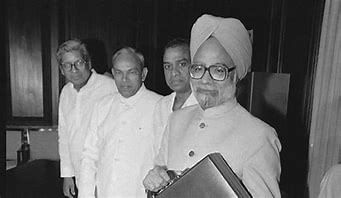
Evolution of Reforms:
- Earlier attempts at economic reforms in the mid-1980s were limited, focusing on partial liberalization and deregulation.
- However, the reforms launched in the early 1990s were more extensive, covering industries, trade, investment, and eventually agriculture.
Impact of Previous Policies:
- Reforms influenced by the "Washington Consensus" in the 1980s had mixed results.
- While they led to higher growth rates, they also increased foreign debt and contributed to the balance-of-payment crisis of 1991.
Causes of the 1991 Crisis:
- The balance-of-payment crisis of 1991 was triggered by factors like the First Gulf War, which caused oil prices to rise and reduced private remittances from Indians working in the Gulf region.
- Deeper issues included rising foreign debt, a high fiscal deficit (over 8% of GDP), and hyperinflation (over 13%).
Bold Steps Amid Criticism:
- Despite widespread criticism, the minority government of the time implemented bold economic reforms in the 1990s.
- Critics included opposition parties, industrialists, media, experts, and the general public.
- While some benefits of reforms have become apparent, criticism remains, particularly regarding their perceived negative impact on the poor and favoritism towards the wealthy.
Call for Distributive Growth:
- There's a growing call for "distributive growth," ensuring that the benefits of reforms reach all sections of society, especially the masses.
- While reforms have led to overall economic growth, there's a need to ensure that this growth benefits everyone, not just a privileged few.
Obligatory Reform
Economic reforms, which involve significant changes in a country's economic policies, are often initiated voluntarily by governments. However, in the case of India, these reforms were spurred by a balance-of-payment crisis in 1991, making them involuntary. Under the guidance of the International Monetary Fund (IMF), India implemented a series of reforms to address its economic challenges. Despite the intended benefits of these reforms, they faced criticism from various sectors of society. Let's delve into the circumstances surrounding India's economic reforms and the conditions imposed by the IMF, along with the ensuing challenges and criticisms.
- Voluntary vs. Involuntary Reform:
- Many countries began economic reforms voluntarily in the 1980s, but India's reforms were triggered by a balance-of-payment crisis, making them involuntary.
- Under the Extended Fund Facility (EFF) program of the IMF, countries receive external currency support to manage their balance-of-payment crises, but this assistance comes with certain conditions.
- IMF Conditionalities and Reforms:
- The IMF imposes conditionalities on countries receiving support, tailored to address their economic challenges.
- In India's case, the conditions required significant economic measures, which were neither formulated nor mandated by India or its public.
- While many experts advocated similar reforms since the 1970s and 1980s, the Rao-Manmohan Government took the initiative to implement them in India.
- Political Challenges and Public Perception:
- The decision to implement reforms faced political challenges due to public perceptions and sentiments.
- Selling state-owned companies or closing them down was controversial, especially in a country where they were seen as symbols of modernity.
- Economic reforms were perceived as bowing down to external pressures, leading to criticism and lack of political consensus.
- Political parties and the public lacked the necessary maturity and understanding to support the reforms, with emotional issues like religion and caste playing a role.
- IMF Conditions for India:
- Devaluation of the rupee by 22%.
- Significant reduction in import tariffs.
- Increase in excise duties to offset revenue shortfalls.
- Annual reduction of government expenditure by 10%.
- Criticism and Ultimate Goal:
- India faced severe criticism for implementing IMF-prescribed reforms, despite the aim to boost growth and competitiveness.
- The ultimate goal of the IMF was to help India achieve balance in its balance-of-payment situation and make macroeconomic and structural adjustments to prevent future crises.
Reform Measures
The economic reform programme, that India launched, consisted of two categories of measures:
1. Macroeconomic Stabilisation Measures: This encompasses all economic policies aimed at increasing overall demand in the economy, whether from domestic sources or external ones. To booster domestic demand, the key lies in boosting the purchasing power of the general populace, which necessitates a focus on generating quality employment opportunities.
2. Structural Reform Measures: This encompasses all government-initiated policy reforms aimed at boosting the overall supply of goods and services in the economy. It involves freeing up the economy to explore its full potential for increased productivity and output. To raise people's purchasing power, the economy needs higher income, which comes from increased economic activity. While income distribution takes time, efforts to increase supply, such as boosting production, are noticeable sooner. Structural reform measures may appear to favor the wealthy or capitalists, but they are crucial for overall growth. Achieving higher growth takes time, especially in politically unstable economies like India, where frequent changes in government hinder long-term progress.
THE LPG
The reform process in India is often referred to as the "LPG" process, which stands for liberalization, privatization, and globalization. Each of these processes plays a specific role in shaping the reform agenda. Liberalization sets the direction of the reforms, privatization defines the path, and globalization represents the ultimate goal. Let's delve into the real meanings of these terms and their significance, both globally and in the Indian context.
Liberalisation
- Liberalization, originating from the ideology of liberalism in the early 19th century, advocates for free market principles.
- It promotes pro-market or pro-capitalistic economic policies, reducing state control and encouraging market influence.
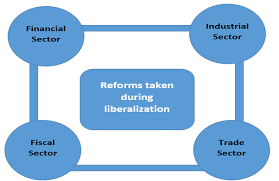
- Historical Context:
- Liberalization gained prominence in Euro-America during the 1970s and 1980s.
- China's "open door policy" in the mid-1980s is a notable example of liberalization, despite lacking typical liberal traits.
- Direction of Economic Shift:
- Liberalization signifies a move towards a more market-oriented economy.
- It involves reducing the influence of the state or planned economy and increasing reliance on the free market or capitalism.
- Indian Context:
- In India, liberalization represents a shift towards a market-oriented economy.
- However, it doesn't mean blindly embracing capitalism but finding a balance between state and market influences.
- Long-term Impact:
- Liberalization can limit the powers of parliaments over time.
- While it promotes economic freedom, it also requires careful management to ensure balanced growth and societal well-being.
Privatisation
- During the 1980s and 1990s, governments in countries like the USA and UK reduced the involvement of the state in various sectors.
- This rollback was inspired by the priorities and beliefs of the New Right, leading to policies like deregulation, privatization, and market reforms in public services.

- Privatization Definition:
- Privatization involves transferring state-owned assets to the private sector.
- The term gained popularity during this period, especially as East European and developing democratic nations embraced it.
- Types of Privatization:
- Full Privatization: This involves transferring 100% state ownership to the private sector, as seen in the UK under Thatcher's regime in the early 1980s.
- Disinvestment: Selling shares of state-owned enterprises to the private sector, even if ownership remains with the state.
- Broad Definition: Any policies promoting private sector expansion or market economy are termed as privatization, including de-licensing industries or cutting subsidies.
- Connection to Liberalization:
- In India, liberalization signifies a move towards market dominance, while privatization acts as the path to achieve it.
- Essentially, any reforms promoting the market economy are considered part of the privatization process in India.
Globalisation
Globalisation is often defined as the increasing integration of economies across nations. It's not just about money; it also involves politics and culture.

- Historical Context
- Globalisation isn't new. Even before some countries existed, economies were interconnected.
- From 1800 to 1930, there was a globalisation wave until events like the Great Depression and World Wars caused setbacks.
- OECD's Role
- The Organisation for Economic Co-operation and Development (OECD) played a key role.
- In the 1980s, it popularized the term globalisation, initially focusing on business aspects.
- This led to the establishment of the World Trade Organization (WTO) in 1994, replacing the General Agreement on Tariffs and Trade (GATT).
- Official Definitions
- The WTO officially defines globalisation as unrestricted movement of goods, services, capital, and labor across borders.
- It aims for a level playing field where there's no distinction between local and foreign products or workers.
- Political Implications
- Many political experts see globalisation as distant events shaping our lives, sometimes without our control.
- Some argue it weakens the power of states, while others say it creates complex interactions between local, national, and global levels.
- India's Role
- India was one of the founding members of the WTO.
- It embraced globalisation willingly, especially after economic reforms began in 1991.
- These reforms, known as Liberalisation, Privatisation, and Globalisation (LPG), aimed to move towards a market-driven economy.
- Indian Perspective on Globalisation
- India views globalisation with a focus on social welfare, emphasizing the importance of lifting people out of poverty.
- International organizations like the IMF and World Bank, along with developed nations, acknowledge that globalisation must benefit everyone, not just the wealthy.
In essence, globalisation isn't just about economics; it's a complex process involving politics, culture, and social welfare. It's about breaking down barriers between nations and striving for a more interconnected world where everyone can benefit.
Generations of Economic Reforms
Though there were no such announcements or proposals while India launched its reforms in 1991, in the coming times, many ‘generations’ of reforms were announced by the governments. 31 A total of three generations of reforms have been announced till date while experts have gone to suggest the fourth generation, too. We may substantiate the components of the various generations of reforms to properly understand the very characteristics and the very nature of the reform process in India, as given below:
First Generation Reforms(1991-2000)
The government introduced the concept of Second Generation economic reforms in 2000-01. The reforms initiated between 1991 and 2000 were labeled as the First Generation reforms.
- Promotion of Private Sector: Policies like de-reservation and de-licensing of industries, removing restrictions on production, and simplifying environmental laws were implemented.
- Public Sector Reforms: Efforts were made to make public sector enterprises profitable and efficient through disinvestment, corporatization, and other measures.
- External Sector Reforms: Policies included abolishing quantitative restrictions on imports, adopting a floating currency exchange rate regime, and allowing full current account convertibility.
- Financial Sector Reforms: Initiatives were taken to reform the banking sector, capital markets, insurance, and mutual funds.
- Tax Reforms: Policies aimed at simplifying, broadening, modernizing, and preventing tax evasion were implemented.
These reforms shifted the economy from a command-based system to a market-driven one, encouraging greater participation from both domestic and foreign private sectors.
Second Generation Reforms (2000-01 onwards):
The government launched this generation of the reformsin the year 2000-01. Basically, the reforms India launched in the early 1990s were not taking place as desired and a need for another set of reforms was felt by the government which were initiated with the title of the Second Generation of economic reforms. The reforms of this generation were not only deeper and delicate but required a higher political will power from the governments. The major components of the reform are as given below:
- Factor Market Reforms
- These reforms are crucial for India's economic success and involve dismantling the Administered Price Mechanism (APM).
- Many products had government-fixed prices, hindering profitability and growth of industries.
- Under these reforms, products like petrol, diesel, and sugar were brought into the market, with subsidies reduced.
- The process is ongoing, with challenges like socio-political concerns about cutting subsidies.
- Public Sector Reforms: Focus on giving public sector enterprises greater autonomy, allowing more involvement in capital markets, and encouraging international partnerships and disinvestment.
Reforms in Government and Public Institutions: Shift from government control to facilitation, emphasizing administrative reform.
Legal Sector Reforms: Aim to abolish outdated laws, reform Indian Penal Code, Labour Laws, and enact provisions for areas like Cyber Law.
- Reforms in Critical Areas
- Includes infrastructure, agriculture, education, and healthcare.
- Emphasis on corporate farming, private sector involvement in agriculture R&D, irrigation, inclusive education, and healthcare.
- Other Emphasized Areas
- Giving states a significant role in initiating reforms, with the center providing support.
- Commitment to fiscal consolidation, with the introduction of Fiscal Responsibility and Budget Management (FRBM) Act.
- Greater tax devolution to states and increased focus on the social sector, particularly healthcare and education.
Despite ongoing reforms, results are mixed, with continued efforts needed.
Third Generation Reforms
The announcement for the third generation of reforms was made during the launch of the Tenth Plan (2002-07). This generation of reforms focuses on achieving fully functional Panchayati Raj Institutions (PRIs) to ensure that the benefits of economic reforms reach the grassroots level.
- Focus on Inclusive Growth
- While constitutional arrangements for decentralized development were in place since the early 1990s, it was in the early 2000s that the government recognized the importance of inclusive growth and development.
- The government believed that without the involvement of the masses, development would lack inclusivity.
- Rationale for Third Generation Reforms
- The government concluded that for development to be truly inclusive, it must involve all sections of society.
- The Eleventh Plan further emphasized the need for these reforms, even with changes in political leadership at the center.
Fourth Generation Reforms
In early 2002, a group of experts introduced the concept of a new phase of reforms in India, characterized by full integration of information technology (IT). This phase was envisioned as leveraging IT to enhance economic reforms, creating a symbiotic relationship where advancements in IT would drive economic progress, and economic reforms would, in turn, facilitate the growth and utilization of IT.
The Reforms Approach (Current Scenario)
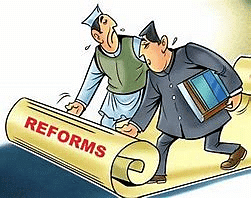
- Evolution of Economic Reforms:
- Economic reforms began globally in the mid-1980s, particularly in Western Europe and Northern America, following the rise of the Washington Consensus.
- Different countries adopted varying approaches, categorized as either gradualist or stop-and-go.
- India's reform process, which started in 1991, has been gradualist, marked by incremental changes and occasional reversals due to the lack of consensus among political parties.
- Other countries like Brazil, Argentina, and South Africa opted for stop-and-go reforms, where sectors needing reform were identified, prerequisites were set, and reforms were implemented simultaneously, yielding expected economic outcomes.
- Challenges and Outcomes of Different Reform Approaches:
- India's gradualist approach helped avoid socio-political instability but didn't deliver desired economic outcomes.
- Meanwhile, stop-and-go reforms in other countries produced expected economic results, though they carried higher socio-political risks.
- However, these nations managed to mobilize public support for reforms, enabling further progress.
- India's Economic Survey recommended incremental reforms due to the complex socio-political landscape.
- Transformational Reforms in India:
- The current Indian government is advocating transformational reforms aimed at inducing behavioral changes.
- Examples include inflation targeting, strategic disinvestment, demonetization, enactment of new laws, and the Aadhar Act.
- These reforms aim to induce significant changes in behavior, resulting in successful outcomes such as resolving debt default cases under the Insolvency and Bankruptcy Code.
- Government Policy and Response:
- While the overall reform scheme remains incremental, recent reforms have been transformative, focusing on structural changes.
- The government's strong mandate has led to expeditious reforms, deviating from gradualism.
- Amidst uncertainties like the COVID-19 pandemic, the government has adopted an agile policy-making approach, providing safety nets while keeping responses flexible based on evolving situations.
- Future Prospects:
- India's first experience with non-gradual reforms occurred in 2003 and propelled growth.
- Despite current challenges like the pandemic and geopolitical issues, India is positioned for faster growth in the coming decade once these obstacles are overcome.
|
138 videos|431 docs|128 tests
|
FAQs on Ramesh Singh Summary: Economic Reforms - Indian Economy for UPSC CSE
| 1. What are the key economic reforms implemented by Ramesh Singh? |  |
| 2. How have these economic reforms impacted the Indian economy? |  |
| 3. What is the purpose of liberalization of trade and investment? |  |
| 4. What is the significance of privatization of state-owned enterprises? |  |
| 5. How have fiscal consolidation measures contributed to the Indian economy? |  |
















